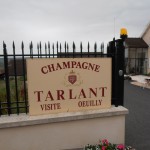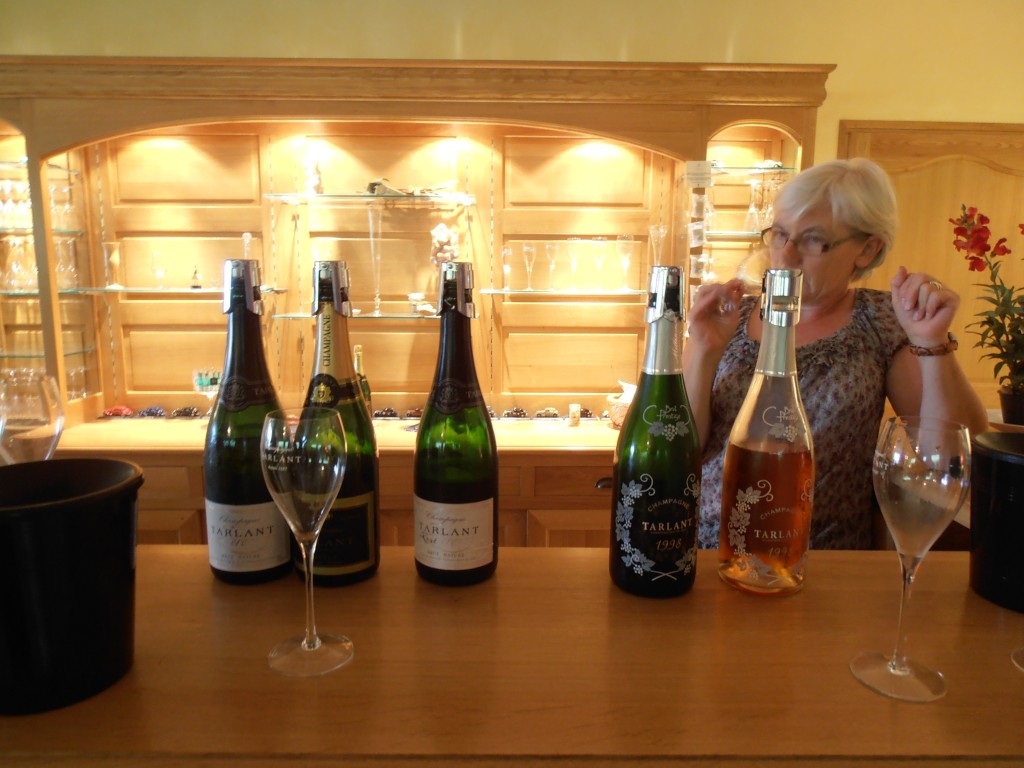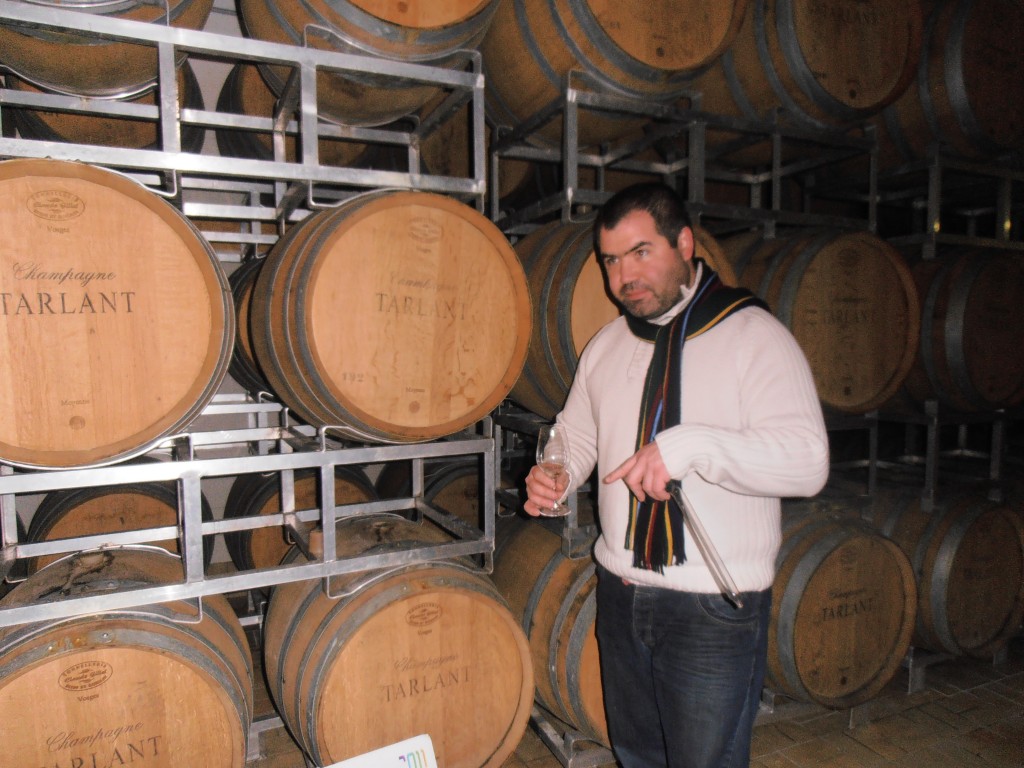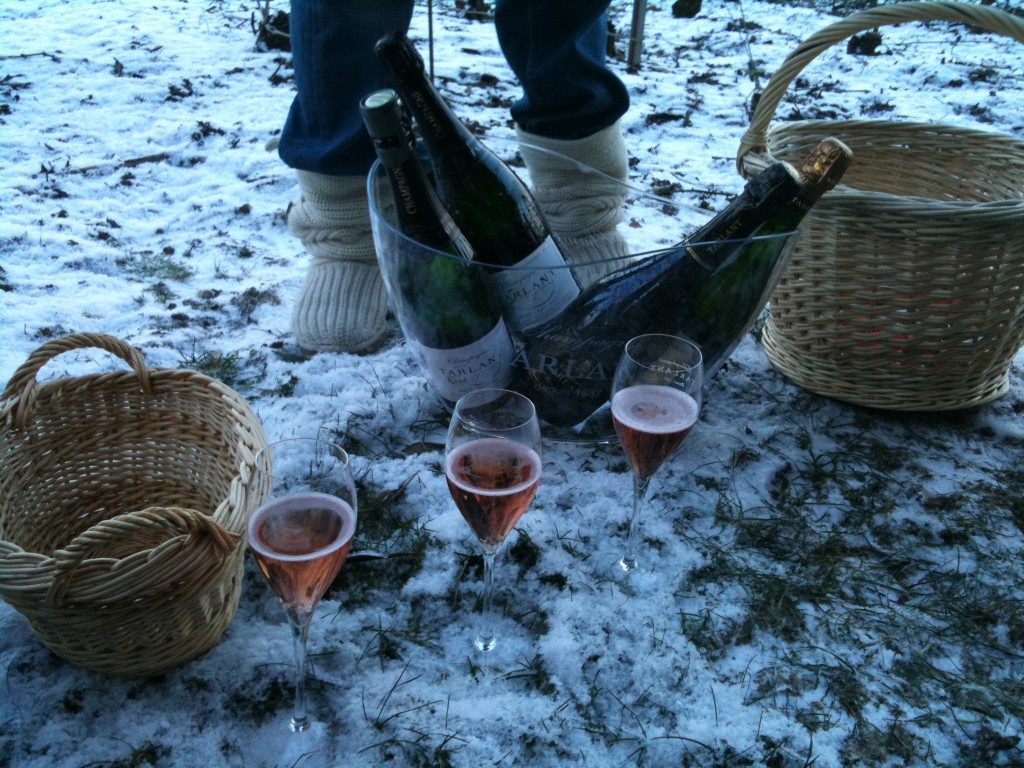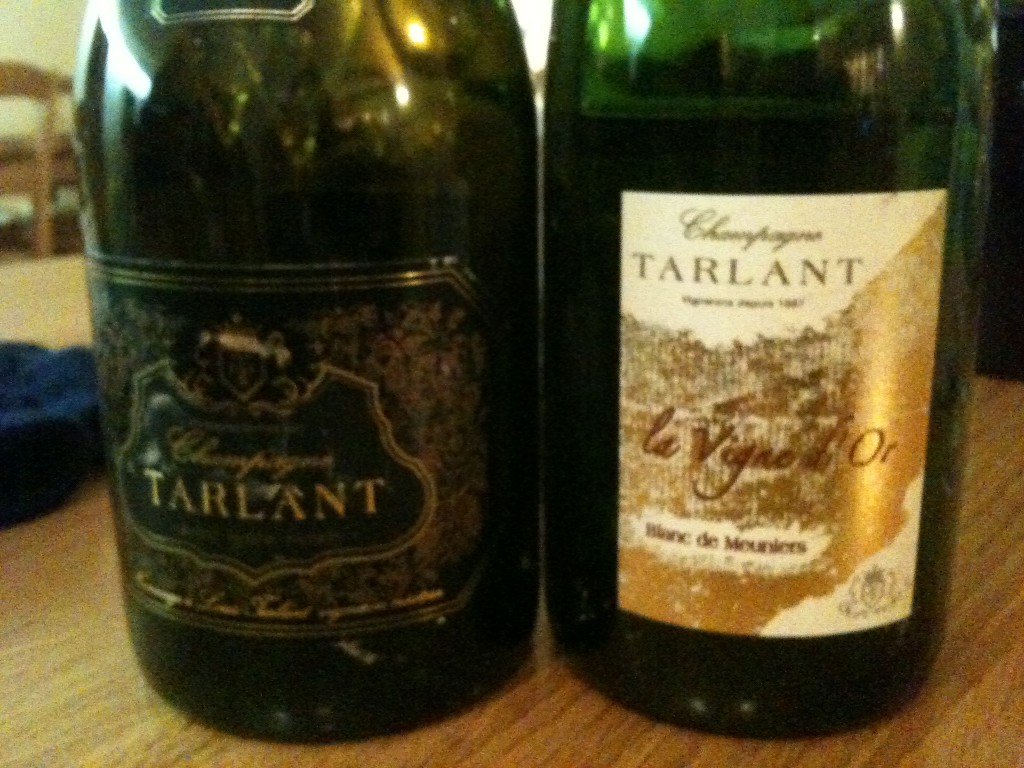I first tasted Tarlant Brut Zero at the European Wine Bloggers conference in Vienna in October 2010 – where I also met the lovely Melanie. It was love at first taste!! The Brut Zero is a “Zero Dosage Champagne” or in other words a Champagne where no sugar has been added at the point of disgorgement. This is pretty unusual as the most Champagnes will have a little sugar mixed up in the liqueur de dosage to balance the high acidity.
A lot of Zero Dosage Champagnes can be pretty austere and mouth puckering. However Tarlant’s Brut Zero is fresh, crisp yet a little rounded with lots of citrus and a little brioche and a great minerality. It is extremely morish hence the reason that I just can’t get enough of it :-)
Tarlant is a real family estate. When visiting the tasting room, one will have a tour and guided tasting with a family member. The tasting room is very clearly sign posted from the Oeuilly turn off, and Tarlant are open Monday to Saturday between 10 am and 12.30pm and 2-6 pm. It is a very welcoming place and every visitor is given a lot of time and attention. There are plenty of opportunities for questions and the family really enjoy sharing their history and Champagne knowledge. I feel very fortunate as I have had 3 different Tarlant visits with 3 different members of the family. My first visit was last August with Micheline, Melanie’s mum. She gave us a great overview of the different terroirs, the blending, and an amazing tasting where she often suggested interesting food pairings. In December I returned and tasted and visited with Benoit Tarlant, Melanie’s brother, and the winemaker today. Benoit is 12th generation winemaker and with him I was fortunate enough to taste several base wines as part of our cellar visit. Benoit also freshly disgorged a new single vineyard cuvee the family will probably release later this year which we tried as part of our tasting.
On Saturday I had my most unusual Champagne tasting ever, as Melanie took us for a candlelight Champagne Picnic in the snow covered vines:-) The vineyard views were amazing, and the 2 Brut Zero Champagnes we tasted in the snow were actually a lot rounder, showing more stone fruit and fine pastry flavours than when tasted at a normal temperature. It was an extremely interesting to feel the flavours change as our glasses were getting colder :-)
There are a few important similarities and characteristics which I have noticed in all three visits. The first is the family’s passion and love for the terroir. The Vallée de la Marne is a landscape very rich in micro climates and a variety of soils (limestone, Sparnacien, chalk and sand). The combination of the two can create a unique expression of the grape variety per vineyard block. All the Tarlant grapes are vinified per vineyard, and it has been really interesting to taste the base wines per block. It was a revelation for me to see how much difference there can be in the same variety and how the terroir manifests itself in each of these wines. With the blending, the Tarlants aim to create a wine which reflects the true flavours of the Vallée de la Marne.
The second is that they all see their Champagne as a wine first. By this I mean they feel Champagne is a (still) wine first, that wine needs to be elegant, complex and most importantly faultless, in order to become a great sparkling wine.
And lastly they are a family of innovators. It seems they are more than willing to take risks if they feel as a family that the risk will benefit the quality of the Tarlant experience. Jean-Mary Tarlant was one of the first to produce Zero Dosage Champagne, when a friend of his asked him to make him some in the early 80’s. In the 70’s he also reverted back to barrel fermentation rather than than tank fermentation which has just about been the norm in Champagne since the fifties. And in 1982 he created the Cuvee Louis, a single vineyard Champagne. Benoit followed in his fathers footsteps and increased the production of Zero dosage wines. They now make up around 80% of the total Tarlant production. To make a Zero Dosage you have to get everything right at the beginning, as there is no sugar added to hide or make up any small defaults. Benoit also created some old vines single Varietals Single Vineyard Champagnes. Old vines have deeper roots hence are better conveyors of the terroir expression. Old vines also will produce less fruit than younger plants, but the flavours are generally more rounded and intense. Again single varietal and single vineyard wines are very unusual in Champagne, where one tends to blend across varieties, vineyards and years to maintain a consistency of taste.
This innovative thinking can also be seen on the marketing side, as Tarlant embraced Social Media very early on and continue to use it as a means to stay in contact with their customers. They try different strategies and look for new and interesting ways to keep people focussed on their brand. A perfect example is the Tarlant Advent Calendar, the 2011 Champagne Christmas project were everyday something small was given away to Tarlant fans in the 25 days up to Christmas. The Chamapgne Christmas project was linked to the Tarlant Facebook place and in the count down to Christmas I collected a really cool Champagne stopper ringtone, found out all about my “vintage” year in Champagne, got some family recipe’s etc etc. This was a simple but wonderful way to engage the consumer in a peak Champagne buying period – it worked as on Christmas day I had Tarlant on my mind and in my glass:-)
Here below are my tasting notes of a few of the wines I tasted during my 3 visits:
Tarlant Brut Zero NV: 1/3 Chardonnay, 1/3 Pinot Meunier, 1/3 Pinot Noir, 2006 base wine. 4 years on the lease. Crisp, fresh almost zesty Champagne, with small elegant bubbles, medium body and flavours of meyer lemon, a little brioche and a hint of tangerine in the finish. The wine has a nice minerality, and as explained before, when tasted at 0 degrees, the flavours became less citrussy and the wine acquired more stone fruit (apricot, white nectarine) and fine puff pastry characteristics. It is a perfect aperitif wine, works well with oysters, sashimi and I have also enjoyed it with a puckering lemon meringue tart :-) The Brut Zero is the flagship Tarlant wine, the wine I fist tried and the one I still adore today!
Tarlant Brut Zero Rose NV 85% Chardonnay, 15% Pinot Noir. The Pinot Noir is added as red wine, and the Chardonnay comes from a very sunny vineyard resulting in a more full bodied and rounded style of Chardonnay. 2007 Base wine. Bright coral pink Champagne, with pink grapefruit and some red currant on the nose and small bubbles. Crisp, elegant and very smooth and rounded Champagne, with flavours of red currant and maybe a little pomegranate, a hint of ripe red apple and a lingering rounded finish.
Tarlant Brut Tradition NV: 50% Pinot Noir, 35% Pinot Meunier, 15% Chardonnay, 2005 base wine and a dosage of 6g/l. A rounded, yet fresh champagne with a great balance, and rich tarte tatin and roasted almond flavours and again a lingering finish. It is a great food wine, perfect for a Champagne breakfast as it pairs very well with a warm apple muffin w lots of butter :-)
Tarlant La Vigne d’Or 2002: 100% old vine Pinot Meunier from the Pierre de Bellevue vineyard, which the Tarlants generally refer to as “la vigne du grand père”, as it was the favourite vineyard of Melanie’s great grand father. He worked in this vineyard all his life till he was well into his eighties. The vineyard is planted on Sparnacien – a subsoil typical for the area made up of combination of chalk and clay and the vines are more than 50 years old. It is a wonderful expression of the potential of Pinot Meunier and as it has aged on the lease for more than 7 years it totally refutes it the often stated fact that Pinot Meurier will not age in a Champagne…
A rich almost sumptuous Champagne, warm golden in colour with very fine bubbles. It has a rich nose of toasted brioche and ripe apricot. It is crisp, yet tropical on the palate, with flavours of ripe mango, a little carree confiture and tarte tatin with a praline like nutty finish. Only 1500 bottles are made and in my opinion they are true gems to be treasured and opened at a very special occasion!
Tarlant La Vigne D’Antan 2000: 100% Chardonnay from a small plot of sandy ungrafted vineyard (Les Sables). Ungrafted vines are rare as hens teeth in France as they are very vulnerable to Phylexora. However this little plot of land is totally sandy, and Phyloxera cannot move and propagate on sandy soil. So when Georges Tarlant saw that 3 plants had survived the disease he requested a soil analysis of the CIVC and when finding out the soil is very sandy he requested permission to propagate the clones of these 3 plants and slowly proceeded to replant the vineyard with these ungrafted vines. The resulting wine represents the essence of Chardonnay. It has a white blossom and apply nose, is extremely elegant, with small bubbles and delicate flavours of quince and yellow apple, some fresh almonds it has a silty almost gritty sandy characteristic in the lingering finish.
Tarlant Mystery Cuvee (name to be decided)2003: 100% Pinot Noir from a steep south facing vineyard (Monctoneaux). We were very fortunate to taste this wine, which had been freshly disgorged à la Volée by Benoit. The Champagne was big, bold and beautiful!! The nose reminded me of a freshly baked cherry pie. The bubbles were fine, and the wine was extremely layered. I am not sure if this was due to the very recent disgorgement but whatever it was I absolutely adored the layers of rich forest fruit – which had a crumble like sensation, a little salty caramel, some toasted pecan and very clean and long saline finish. This Champagne had been bottled in 2004 so spend about 7.5 years on lees. The name of this wine has not been finalized yet but it looks like it may be called “la Vigne Rouge”. It is yet another wonderful example of how diverse and expressive the Champagne Terroir can be!!
Tarlant Cuvee Louis: This is the first single vineyard Champagne Tarlant ever made. It is named after Louis Tarlant who was the first to make a sparkling Tarlant in the 20’s.
The vineyard, Les Crayons, is located right next to the meandering Marne river. The subsoil is chalk and the vines are more than 60 years old. The vineyard is planted with Chardonnay and Pinot Noir. The base wine for the Cuvee Lois we tried was 1998 (80%) and a little of 1996 and 1997 of the previous Cuvee Louis. The wine had been disgorged in 2011, hence spend 11 years aging on the lees. The resulting wine is a fabulous food wine, rich and complex, with a toasty smokey manuka honeyed nose. The bubbles are very creamy and fine, the wine is beautifully balanced had a nice mouth feel and flavours of quince pie, tarte tatin and apricot turnover, lots of toasted hazelnuts and a sweet pastry characteristic in the lingering finish. The wine is tasting very young and fresh, and I feel it easily can age another 10 years in the cellar.
More tasting notes and wines can be found on Vinogusto.com

